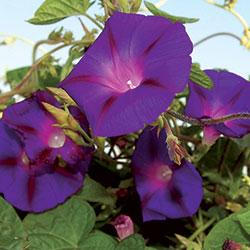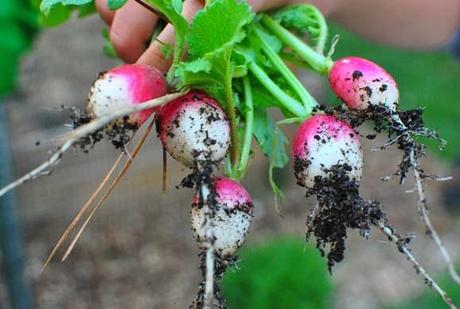Continuing with the homage to Durham County’s new seed library, let’s examine the difference between open-pollinated seeds and heirloom seeds.
What’s the difference between an open-pollinated seed and an heirloom seed?
Heirlooms are seeds of plants that have been tended, selected, shared, and handed down for generations within a particular location or community. Some seed companies categorize heirlooms by the age of the variety (e.g., if seeds of a particular plant have been recorded as being handed down for 100 years or more). Seed Savers Exchange classifies heirlooms by tracing a plant’s documented history of preservation, emphasizing the plant’s ties to a particular group of people.

Grandpa Ott’s morning glory. Photo by Seed Savers Exchange. http://www.seedsavers.org/onlinestore/Flower-Seeds/Flower-Grandpa-Otts.html
For example, Seed Savers Exchange founder Diane Ott Whealey’s great-grandparents brought some morning glory seeds from Bavaria to Iowa in the 1800s. Upon her grandfather’s death, Diane Ott Whealey founded the Seed Savers Exchange to continue this hand-me-down tradition of conservation, and Grandpa Ott’s morning glories are found in gardens across the country, including mine.
Seed Savers Exchange further differentiates between heirlooms and “heritage” varieties, which are “old-timey” plants that may have no particular connection to a particular people. And there are “modern heirlooms,” or modern open-pollinated varieties in various stages of emerging tradition, being bred and selected by a handful of seed companies who care deeply about plant genetic diversity and stewardship.

- Open-pollinated seeds, as we learned yesterday, are pollinated by insects, birds, wind, or other means, whose offspring closely resemble their parents from generation to generation. OPs may be of any age or tradition.
- Heritage varieties are old, traditional open-pollinated plants, that may or may not be connected to a group of people. Heritage varieties are open-pollinated, but not all OPs are heritage varieties.
- Heirloom varieties are old, traditional open-pollinated plants that are variously defined as being handed down by generations in a particular location or context, and/or which may be greater than 100 years old. Heirlooms are open-pollinated, but not all OPs are heirlooms. Heirlooms are heritage varieties.
- “Modern heirlooms” is another name for open-pollinated plants bred more recently (say, post-advent of commercial agriculture, up until today), whose tradition among groups of people or locations is emerging. They’re neither heirlooms in the traditional sense, nor are they heritage varieties, but they are being bred in the same tradition and may become heirlooms or heritage varieties in years to come.
Study hard. The exam will be tomorrow.

